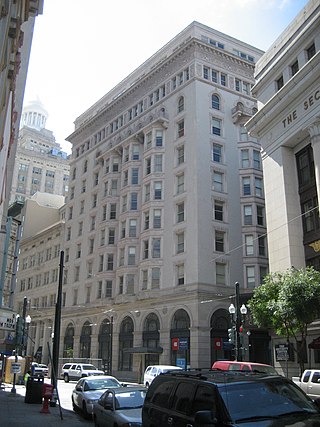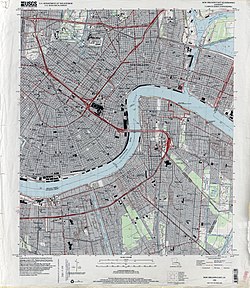
The French Quarter, also known as the Vieux Carré, is the oldest neighborhood in the city of New Orleans. After New Orleans was founded in 1718 by Jean-Baptiste Le Moyne de Bienville, the city developed around the Vieux Carré, a central square. The district is more commonly called the French Quarter today, or simply "The Quarter", related to changes in the city with American immigration after the 1803 Louisiana Purchase. Most of the extant historic buildings were constructed either in the late 18th century, during the city's period of Spanish rule, or were built during the first half of the 19th century, after U.S. purchase and statehood.

The Central Business District (CBD) is a neighborhood of the city of New Orleans, Louisiana, United States.

The Garden District is a neighborhood of the city of New Orleans, Louisiana, United States. A subdistrict of the Central City/Garden District Area, its boundaries as defined by the New Orleans City Planning Commission are: St. Charles Avenue to the north, 1st Street to the east, Magazine Street to the south, and Toledano Street to the west. The National Historic Landmark district extends a little farther.

The Pitot House is a historic landmark in New Orleans, Louisiana, and is listed on the National Register of Historic Places.

Place St. Charles, located at 201 St. Charles Avenue in the Central Business District of New Orleans, Louisiana, is a 53-story, 645-foot (197 m) skyscraper designed in the post-modern style by Moriyama & Teshima Architects with The Mathes Group, now Mathes Brierre Architects, as local architect. It is the second-tallest building in both the city of New Orleans and the state of Louisiana, and it is taller than Louisiana's tallest peak, Driskill Mountain.

Hibernia Bank Building, at 812 Gravier Street at the corner of Carondelet Street in the Central Business District of New Orleans, Louisiana, is a 23-story, 355 feet (108 m)-tall skyscraper. It was once the headquarters of Hibernia National Bank. At the time it was completed in 1921, it was the tallest building in Louisiana. In 1932, the state capitol took that title.

National American Bank Building is a 23-story 325 feet (99 m)-tall skyscraper in the Central Business District of New Orleans, Louisiana, It was completed in 1929 and listed on the National Register of Historic Places in 1986. It is topped with a distinctive 6-story octagonal tower with a golden Art Deco finial. Its address is 200 Carondelet Street. Originally a commercial building, it was renovated for use as a residential building after Hurricane Katrina.

The Presbytère is an architecturally important building in the French Quarter of New Orleans, Louisiana. It stands facing Jackson Square, adjacent to the St. Louis Cathedral. Built in 1813 as a matching structure for the Cabildo, which flanks the cathedral on the other side, it is one of the nation's best examples of formal colonial Spanish architecture. It was designated a National Historic Landmark in 1970, and is now a property of the Louisiana State Museum.

The Hennen Building, also known as the Canal-Commercial Building,Maritime Building, and briefly the Latter & Blum Building, is an 11-story, 158 feet (48 m)-tall skyscraper in New Orleans, Louisiana USA. Individually listed on the National Register of Historic Places (NRHP), the building is located at 800 Common Street at the uptown lake corner with Carondelet Street. It is also NRHP-listed as a contributing building in New Orleans' Central Business District. The building is New Orleans' first and oldest skyscraper, holding the title of the city's tallest building from 1895-1904.

The Napoleon House, also known as the Mayor Girod House or Nicolas Girod House, is a historic building at 500 Chartres Street in the French Quarter of New Orleans, Louisiana, United States. Built in 1794 and enlarged in 1814, its name derives from the local legend that it was intended as a residence for Napoleon Bonaparte after his exile. A plan to bring Napoleon to Louisiana was halted by news of his death in 1821.

The U.S. Custom House, also known as the Old Post Office and Custom House, is a historic government building at 423 Canal Street in New Orleans, Louisiana. It was designated a National Historic Landmark, receiving this designation in 1974 and noted for its Egyptian Revival columns. Construction on the building, designed to house multiple federal offices and store goods, began in 1848 and didn't finish until 1881 due to redesigns and the American Civil War. The U.S. Customs offices have been located there since the late 19th century.
The Bennett Plantation House in Alexandria, Louisiana was built in 1854. The house and associated store building were added to the National Register of Historic Places in 1979.
Carondelet Street is a major street in New Orleans. It is one-way eastbound. It starts at Robert Street in the Uptown neighborhood and continues to Josephine Street. One must turn left at this point, and then right. Carondelet continues up to Canal Street.

A Cotton Office in New Orleans, also known as Interior of an Office of Cotton Buyers in New Orleans and Portraits in an Office (New Orleans), is an oil painting by Edgar Degas. Degas depicts the interior of his maternal uncle Michel Musson's cotton firm in New Orleans. Musson, Degas's brothers René and Achille, Musson's son-in-law William Bell, and other associates of Musson are shown engaged in various business and leisure activities while raw cotton rests on a table in the middle of the office.

Favrot & Livaudais (1891–1933) was an architectural firm in New Orleans, Louisiana. The firm designed many buildings that are listed on the National Register of Historic Places.
The following is a timeline of the history of the city of New Orleans, Louisiana, USA.

The Dew Drop Inn, at 2836 LaSalle Street, in the Faubourg Delassize section of Central City neighborhood of New Orleans, Louisiana, is a former hotel and nightclub that operated between 1939 and 1970, and is noted as "the most important and influential club" in the development of rhythm and blues music in the city in the post-war period. The venue primarily served the African-American population in the then heavily segregated Southern United States.

Poydras Street is a street that serves as the main artery of the New Orleans Central Business District, in New Orleans, Louisiana. The street is named for Julien de Lallande Poydras. Many of the city of New Orleans' and the state of Louisiana's tallest buildings have been built on the street since it was widened in the mid 1960s. The street also hosts several historic structures and is the boundary between two United States National Register of Historic Places districts.

The New Orleans Lower Central Business District is a historic district in New Orleans, Louisiana which was listed on the National Register of Historic Places (NRHP) in 1991. It may be referred to as Lower Central Business District. Along with the NRHP-listed New Orleans Upper Central Business District to the south, across the redeveloped Poydras Street, it is included within the larger New Orleans Central Business District area. To the north, between N. Peters and N. Rampart, the district borders the historic, NRHP-listed Vieux Carre, which is a U.S. National Historic Landmark.





















